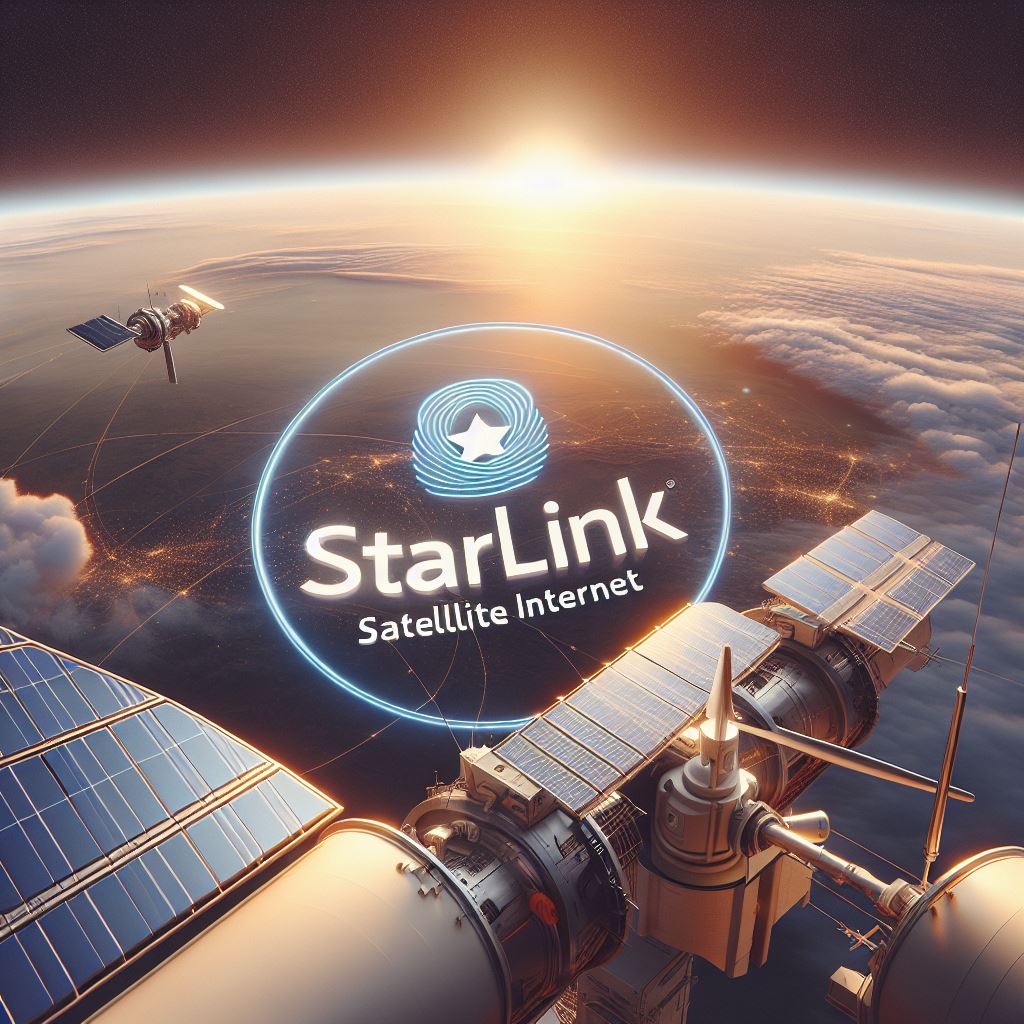Here are the top 5 satellite internet services, along with their expected speeds, approx. costs & breakdowns:
- Starlink
- Speeds: 25-220 Mbps download, 5-25 Mbps upload
- Cost: $120 per month, with a one-time equipment fee of $499
- HughesNet
- Speeds: 25-100 Mbps download, 3-5 Mbps upload
- Cost: $50-$120 per month, with equipment fees ranging from $15 monthly to $400 upfront
- Viasat
- Speeds: 12-150 Mbps download, 3 Mbps upload
- Cost: $70-$300 per month, with equipment fees ranging from $15 monthly to $300 upfront
- OneWeb
- Speeds: 50-200 Mbps download, 10-20 Mbps upload
- Cost: Pricing varies based on region and plan specifics
- Amazon’s Project Kuiper
- Speeds: Expected to be 50-400 Mbps download, 10-30 Mbps upload
- Cost: Pricing details are yet to be fully disclosed as the service is still in the deployment phase
These services offer a range of speeds and pricing to cater to different needs and locations.

Starlink – Satellite Internet Services
Starlink: Revolutionizing Global Internet
Starlink, a visionary project by SpaceX, was publicly announced in 2015 with the ambitious goal of providing high-speed internet across the globe via a constellation of low Earth orbit (LEO) satellites. The journey began with the launch of the first batch of 60 operational satellites in May 2019. Fast forward to 2024, Starlink boasts over 7,000 satellites in orbit, serving millions of users worldwide.
Compatibility and Cost
Starlink is designed to be compatible with most modern routers. The basic residential plan is priced at approximately $120 per month, with a one-time equipment fee of $499.
Setting Up Your Starlink Network
- Connect to the Network: Once the router is powered on, it will create a Wi-Fi network. Connect your devices to this network using the default network name (SSID) and password provided in the Starlink kit.
- Optional Ethernet Connection: If you prefer a wired connection, you can use an Ethernet cable. Plug one end of the Ethernet cable into the Ethernet port on the Starlink router and the other end into your device or an Ethernet switch for multiple wired connections.
- Use the Starlink App: Download the Starlink app on your smartphone to manage your network settings, monitor connectivity, and troubleshoot any issues.
Reasons to Choose Starlink
- High-speed internet in remote areas: Starlink provides download speeds ranging from 50 Mbps to 150 Mbps, with upload speeds of 20 Mbps.
- Easy setup with a self-installation kit: The Starlink kit includes everything you need to get online in minutes, including a phased-array antenna, Wi-Fi router, and necessary cables.
- Unlimited data on most plans: Enjoy unlimited data without worrying about data caps.
- Low latency compared to other satellite providers: Experience latency as low as 20-40 ms, making it suitable for online gaming and video calls.
- Reliable connectivity for streaming and gaming: The tri-band Wi-Fi 6 router supports up to 235 devices, ensuring smooth streaming and gaming experiences.
- Constantly expanding satellite network: With over 7,000 satellites in orbit, Starlink continues to expand its coverage and improve service quality.
- No long-term contracts: Flexibility to cancel anytime without being locked into long-term commitments.
- Portable options for RVs and boats: Starlink offers portable solutions for users on the move, ensuring connectivity wherever you go.
- Regular updates and improvements: Continuous software and hardware updates enhance performance and reliability.
- Support for multiple devices: The Starlink router covers up to 297 m² (3,200 ft²) and supports multiple devices simultaneously.

Starlink Review
Starlink has revolutionized internet access in rural and remote areas, providing high-speed connectivity where traditional ISPs fall short. Users appreciate the easy setup and the significant improvement in internet speeds. However, the service is not without its drawbacks. The high cost, both for the initial setup and monthly fees, can be a barrier for some. Additionally, weather conditions can affect the signal, leading to occasional interruptions. Despite these issues, many users find Starlink to be a game-changer, especially in areas with limited internet options. The ongoing expansion of the satellite network promises even better coverage and speeds in the future. Overall, Starlink is a solid choice for those in need of reliable internet in hard-to-reach places.

HughesNet – Satellite Internet Services
HughesNet, a subsidiary of EchoStar, was founded in 1971 as Digital Communications Corporation. It pioneered satellite internet services, launching its first consumer service, DirecPC, in 1996, which was later renamed Direcway and then HughesNet in 2006. HughesNet has since become a leading provider of satellite internet, especially in rural and remote areas.
Compatibility and Cost
HughesNet is compatible with most modern routers. The service plans range from $49.99 to $94.99 per month, with equipment leasing fees between $14.99 and $19.99 per month.
- Connect to the Network: You can now connect your devices to the network. For wired connections, use Ethernet cables to connect your devices to the router. For wireless connections, search for the Wi-Fi network name (SSID) provided on the back of the modem or router, and enter the password to connect.
- Access the System Control Center – APP: To manage your network settings, open a web browser and go to www.systemcontrolcenter.com. Here, you can access Wi-Fi settings, monitor connectivity, and troubleshoot any issues.
Reasons to Choose HughesNet
- Available in remote areas: HughesNet provides coverage in areas where traditional ISPs may not reach.
- No hard data caps: While there are data limits, HughesNet does not cut off your internet once you reach them; instead, speeds may be reduced.
- Consistent speeds: Offers download speeds of up to 25 Mbps and upload speeds of up to 3 Mbps.
- Bonus data during off-peak hours: Additional data is available between 2 AM and 8 AM local time, allowing for heavy usage without impacting your monthly data allowance.
- Easy installation: The HughesNet kit includes an indoor modem with built-in Wi-Fi router, an outdoor antenna system, and up to 125 feet of RG6 coaxial cable.
- Reliable customer service: HughesNet is known for its responsive and helpful customer support.
- Built-in Wi-Fi: The modem includes a built-in Wi-Fi router, eliminating the need for additional equipment.
- Affordable entry-level plans: HughesNet offers various plans to suit different budgets, starting at competitive prices.
- Good for basic internet needs: Ideal for browsing, emailing, and streaming standard-definition videos.
- Supports multiple devices: The built-in Wi-Fi router can handle multiple devices simultaneously, ensuring connectivity for all your gadgets.

HughesNet Review
HughesNet offers a viable internet solution for rural and remote areas where other ISPs are unavailable. Users appreciate its consistent speeds and the availability of bonus data during off-peak hours. However, the service comes with high latency, making it less suitable for activities like online gaming or video conferencing. The equipment fees and long-term contracts can also be a drawback for some users. Despite these issues, HughesNet remains a reliable option for those needing basic internet access in underserved regions. The service’s ability to provide connectivity where other options fail is its strongest selling point, making it a valuable resource for many households.

Viasat – Satellite Internet Services
Viasat, Inc. was founded in 1986 by Mark Dankberg, Mark Miller, and Steve Hart. Initially focused on defense contracts, Viasat expanded into commercial satellite communications. It launched its first consumer satellite internet service, Exede, in 2012, which was later rebranded as Viasat Internet. Today, Viasat is a leading provider of satellite internet services, especially in rural and remote areas.
Compatibility and Cost
Viasat is compatible with most modern routers. The service plans range from $50 to $300 per month, with equipment leasing fees between $15 and $20 per month.
- Connect to the Network: You can now connect your devices to the network. For wired connections, use Ethernet cables to connect your devices to the router. For wireless connections, search for the Wi-Fi network name (SSID) provided on the back of the modem or router, and enter the password to connect.
- Configure Your Network: Access your router’s settings by typing its IP address into a web browser. Follow the setup instructions to configure your Wi-Fi network, including setting a network name (SSID) and password.
Reasons to Choose Viasat
- Available in remote areas: Viasat provides coverage in areas where traditional ISPs may not reach.
- No hard data caps: While there are data limits, Viasat does not cut off your internet once you reach them; instead, speeds may be reduced.
- Consistent speeds: Offers download speeds of up to 100 Mbps and upload speeds of up to 3 Mbps.
- Bonus data during off-peak hours: Additional data is available between 12 AM and 5 AM local time, allowing for heavy usage without impacting your monthly data allowance.
- Easy installation: The Viasat kit includes an indoor modem with built-in Wi-Fi router, an outdoor antenna system, and necessary cables.
- Reliable customer service: Viasat is known for its responsive and helpful customer support.
- Built-in Wi-Fi: The modem includes a built-in Wi-Fi router, eliminating the need for additional equipment.
- Affordable entry-level plans: Viasat offers various plans to suit different budgets, starting at competitive prices.
- Good for basic internet needs: Ideal for browsing, emailing, and streaming standard-definition videos.
- Supports multiple devices: The built-in Wi-Fi router can handle multiple devices simultaneously, ensuring connectivity for all your gadgets.

Viasat Review
Viasat offers a viable internet solution for rural and remote areas where other ISPs are unavailable. Users appreciate its consistent speeds and the availability of bonus data during off-peak hours. However, the service comes with high latency, making it less suitable for activities like online gaming or video conferencing. The equipment fees and long-term contracts can also be a drawback for some users. Despite these issues, Viasat remains a reliable option for those needing basic internet access in underserved regions. The service’s ability to provide connectivity where other options fail is its strongest selling point, making it a valuable resource for many households.

OneWeb – Satellite Internet Services
OneWeb, founded in 2012 by Greg Wyler, aims to provide global internet connectivity through a constellation of low Earth orbit (LEO) satellites. The company launched its first six satellites in February 2019. Despite filing for bankruptcy in March 2020, OneWeb emerged from bankruptcy later that year with new investments from the UK government, Bharti Global, and others. In 2023, OneWeb merged with Eutelsat to form Eutelsat OneWeb, enhancing its capabilities and reach.
Compatibility and Cost
OneWeb is compatible with most modern routers. The service is primarily sold through partnerships with telecom providers, so costs can vary. Generally, OneWeb’s service is expected to be competitive with other satellite internet providers, though specific pricing details are often tailored to business and government clients.
- Connect to the Network: Use an Ethernet cable to connect your data device (such as a router or computer) to the user terminal. This cable transmits the internet signal from the terminal to your device.
- Configure the Network: Access the terminal’s configuration settings through a web browser. Typically, you would enter the terminal’s IP address (e.g., 192.168.x.1) to access the setup wizard. Follow the on-screen instructions to complete the setup.
- Download Ephemeris File: If required, download the ephemeris file from OneWeb’s designated site and upload it through the setup wizard. This file helps the terminal align with the satellite network.
- Update and Finalize: Allow the terminal to stay online for about 30 minutes to receive any over-the-air software updates. This ensures your device is running the latest firmware and configurations.
Reasons to Choose OneWeb
- Global coverage: OneWeb’s constellation consists of 648 microsatellites, providing worldwide internet access.
- Low latency: Experience latency as low as 30-50 ms, making it suitable for real-time applications like video calls and online gaming.
- High-speed internet: Each satellite is capable of delivering at least 8 gigabits per second of throughput using its high throughput Ku-band payload.
- Reliable connectivity: The network design ensures consistent and reliable internet access, even in challenging environments.
- Suitable for remote areas: OneWeb’s satellites operate in 1,200 km orbits, ensuring coverage in remote and underserved regions.
- Supports multiple devices: The system can handle multiple devices simultaneously, providing robust connectivity for homes and businesses.
- Easy integration with existing networks: OneWeb’s technology is designed to seamlessly integrate with existing network infrastructure.
- Scalable solutions: The constellation is scalable, with plans to expand up to 47,844 satellites to meet growing demand.
- Strong backing from major investors: Supported by significant investments from companies like Airbus Defence and Space, Virgin, and Qualcomm.
- Continuous technological advancements: OneWeb is committed to ongoing innovation, regularly updating its technology to enhance performance and reliability.

OneWeb Review
OneWeb offers a promising solution for global internet connectivity, particularly in remote and underserved areas. Its low Earth orbit satellites provide low latency and high-speed internet, making it a strong contender in the satellite internet market. Users appreciate the reliable connectivity and the ability to support multiple devices. However, the service is primarily targeted at businesses and governments, which can limit its direct availability to consumers. The higher initial costs and dependency on telecom partners for service delivery are notable drawbacks. Despite these challenges, OneWeb’s continuous technological advancements and strong backing from major investors position it as a significant player in the satellite internet industry. Overall, OneWeb is a robust option for those needing reliable internet in challenging locations, though it may not be the best fit for individual consumers looking for a straightforward, cost-effective solution.

Project Kuiper – Satellite Internet Services
Project Kuiper, initiated by Amazon in 2019, aims to provide global broadband access through a constellation of over 3,000 low Earth orbit (LEO) satellites. The project was named after the Kuiper Belt and seeks to bridge the digital divide by delivering high-speed internet to underserved and remote areas. The first prototype satellites were launched in 2023, with plans to begin commercial service in 2024. Amazon has invested over $10 billion in this initiative, securing multiple launch contracts to deploy the satellite network.
Compatibility and Cost
Project Kuiper is compatible with most modern routers. This is an outdoor antenna. The service is expected to be competitively priced, with costs projected to be similar to or lower than Starlink, which is around $120 per month. The customer terminals are designed to be affordable, with production costs estimated at less than $400 each.
- Connect to Power and Network: The customer terminal will need to be connected to a power source and your local network. This typically involves plugging the terminal into a power outlet and connecting it to your router or network switch.
- Configure the Device: Follow the setup instructions provided by Amazon. This usually involves using a web interface or a mobile app to configure the terminal, ensuring it is properly aligned and connected to the satellite network.
- Test the Connection: Once everything is set up, test the connection to ensure that the terminal is communicating with the satellites and providing the expected internet speeds.
Reasons to Choose Project Kuiper
- Global coverage: Project Kuiper aims to deploy a constellation of 3,236 satellites in low Earth orbit (LEO), providing worldwide internet access.
- Low latency: Experience latency as low as 20-40 ms, making it suitable for real-time applications like video calls and online gaming.
- High-speed internet: Each satellite is capable of delivering high-speed broadband with download speeds of up to 400 Mbps.
- Reliable connectivity: The network design ensures consistent and reliable internet access, even in challenging environments.
- Suitable for remote areas: Project Kuiper’s satellites operate at altitudes ranging from 590 km to 650 km, ensuring coverage in remote and underserved regions.
- Supports multiple devices: The system can handle multiple devices simultaneously, providing robust connectivity for homes and businesses.
- Easy integration with existing networks: Project Kuiper’s technology is designed to seamlessly integrate with existing network infrastructure.
- Scalable solutions: The constellation is scalable, with plans to expand further to meet growing demand.
- Strong backing from major investors: Supported by significant investments from Amazon, with over $10 billion committed to the project.
- Continuous technological advancements: Project Kuiper is committed to ongoing innovation, regularly updating its technology to enhance performance and reliability.

Project Kuiper Review
Project Kuiper offers a promising solution for global internet connectivity, particularly in remote and underserved areas. Its low Earth orbit satellites provide low latency and high-speed internet, making it a strong contender in the satellite internet market. Users appreciate the reliable connectivity and the ability to support multiple devices. However, the service is primarily targeted at businesses and governments, which can limit its direct availability to consumers. The higher initial costs and dependency on telecom partners for service delivery are notable drawbacks. Despite these challenges, Project Kuiper’s continuous technological advancements and strong backing from major investors position it as a significant player in the satellite internet industry. Overall, Project Kuiper is a robust option for those needing reliable internet in challenging locations, though it may not be the best fit for individual consumers looking for a straightforward, cost-effective solution.

